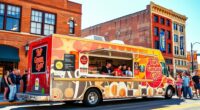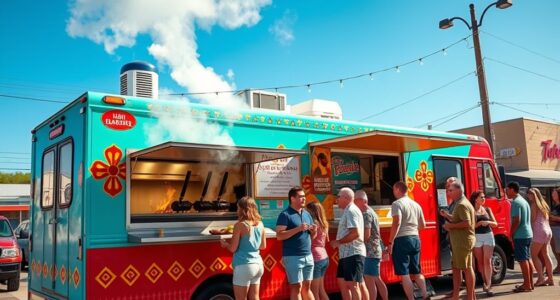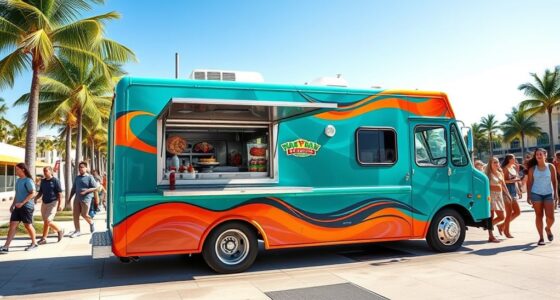To start a food truck in Tacoma, WA, you’ll need to complete an online permit application, follow health and safety inspections, and choose a suitable vehicle and space. Focus on designing a standout brand with eye-catching visuals, local ingredients, and a menu that reflects Tacoma’s diversity. Use social media and community events to build your presence. If you want to learn more about financing, equipment, and marketing, keep exploring what it takes to succeed in Tacoma’s vibrant food scene.
Key Takeaways
- Obtain required permits and licenses through Tacoma’s digital portal, including health, vehicle registration, and insurance documentation.
- Choose a suitable, visually appealing vehicle and outfit it with durable, efficient equipment tailored to your menu.
- Develop a unique menu emphasizing local ingredients and bold flavors, incorporating seasonal and community-focused offerings.
- Design eye-catching branding and high-quality visual content to promote your food truck on social media and at community events.
- Engage with the local community by participating in festivals, markets, and building a strong online presence for sustained visibility.
Navigating Tacoma’s Food Scene
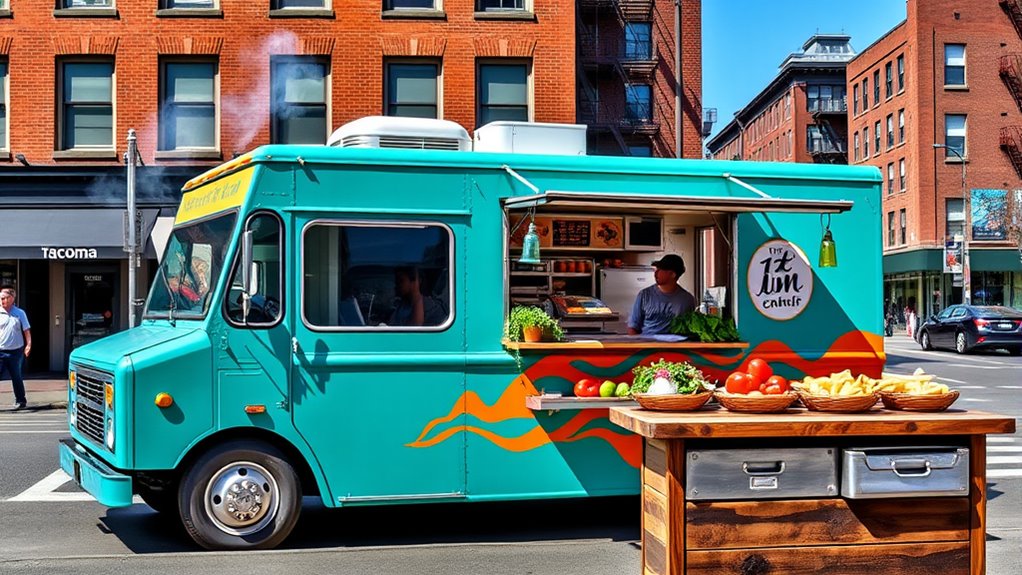
Tacoma’s food scene offers a vibrant mix of flavors and cuisines that are easy to explore, especially with the city’s growing number of food trucks. To stand out, focus on strong food truck branding that reflects your unique style and menu. Effective branding helps attract customers and builds recognition in a competitive market. Pair this with social media marketing to boost visibility—post regularly about your location, specials, and customer favorites. Engaging content on platforms like Instagram and Facebook creates buzz and encourages loyalty. Use eye-catching visuals and authentic stories to connect with your audience. Staying consistent with your branding and online presence makes it easier for locals and visitors to find and remember your truck, helping you thrive in Tacoma’s dynamic food scene. Incorporating branding strategies backed by proven marketing tactics can give your food truck a competitive edge.
Understanding Local Requirements

To get your food truck up and running in Tacoma, you’ll need to understand the local requirements. This includes completing the online permit application, knowing how often inspections are scheduled, and following the procedures for each visit. Additionally, you must park in designated street zones to stay compliant with city regulations. Considering the importance of adhering to local regulations, it’s also helpful to familiarize yourself with the self watering plant pots that can be used for your food truck’s outdoor seating area.
Online Permit Application Process
Finding your way through the online permit application process is essential for getting your food truck approved to operate in Tacoma. Start by visiting the city’s official website, where you’ll find the digital portal to submit your permits. Make sure your food truck branding aligns with local regulations, including health and safety standards. You’ll need to upload detailed documents such as food handler permits, vehicle registration, and proof of insurance. Take your time filling out each section accurately to avoid delays. Once submitted, monitor your email for any updates or additional requests from city officials. Completing this process efficiently helps you establish customer loyalty early on, as a smooth launch builds trust. Staying informed about local requirements streamlines your path to becoming a successful food truck entrepreneur in Tacoma.
Schedule Inspection Frequency and Procedures
Understanding the inspection schedule is essential for keeping your food truck compliant with local regulations. Tacoma requires regular inspections to ensure your vehicle meets health and safety standards. Typically, you’ll need to schedule inspections every six to twelve months, depending on specific conditions. To stay compliant, familiarize yourself with the compliance procedures set by local authorities, which often include food safety checks, equipment inspections, and vehicle sanitation assessments. Plan ahead to avoid delays or penalties by booking inspections in advance and maintaining proper documentation. Keep track of when your next inspection is due, and always follow the outlined procedures to pass smoothly. Staying on top of your inspection schedule helps you avoid violations and keeps your food truck operating legally and safely.
Designated Street Parking Zones
Knowing where you can legally park your food truck is essential for staying compliant with Tacoma’s regulations. You need to understand designated street parking zones, which are marked by street signage and specific parking regulations.
To stay within the rules:
- Check for posted street signage indicating parking restrictions or permit requirements.
- Confirm that your chosen zone allows food trucks or mobile vending.
- Avoid restrictions such as fire lanes, no-parking zones, or meters that don’t permit long-term parking.
Pay close attention to signage, as it clearly outlines parking regulations. Failing to adhere can result in fines or being towed. Always verify the signage and zone designations before parking your food truck to ensure compliance.
Setting Up Your Base of Operations
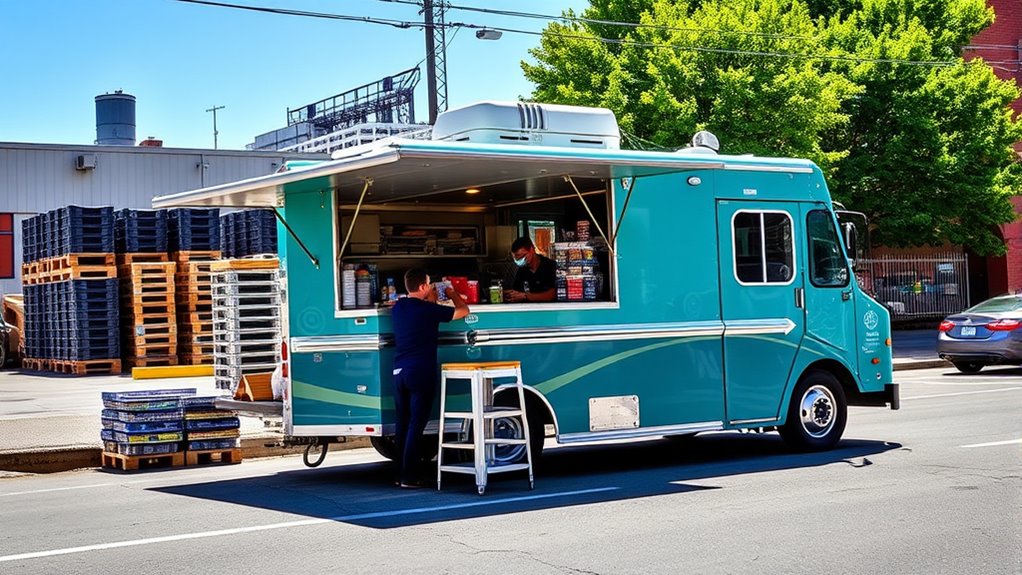
Setting up your base of operations starts with choosing the right kitchen setup, whether you opt for a shared commercial kitchen or establish your own space. You’ll need to explore licensing options that fit your needs and meet local regulations. Selecting the right commercial appliances is essential to keep your food prep efficient and compliant. Incorporating testing tools into your operations can help ensure consistency and quality in your food offerings.
Shared Kitchen Licensing Options
To launch your food truck smoothly, exploring shared kitchen licensing options can be a practical choice. Shared kitchens provide a cost-effective way to meet licensing requirements without investing in a dedicated commercial space. When considering licensing options, keep these steps in mind:
- Research local shared kitchen facilities that qualify for food service licensing.
- Verify that the shared kitchen complies with health and safety regulations specific to Tacoma, WA.
- Ensure the licensing options available allow you to operate legally and safely within your food truck business.
Using a shared kitchen simplifies the licensing process, reduces startup costs, and offers flexible hours. This approach helps you focus on perfecting your menu while ensuring all regulatory standards are met efficiently.
Commercial Kitchen Appliances Selection
Are you selecting the right commercial kitchen appliances to guarantee your food truck operates efficiently? Your choice of appliances directly impacts your ability to execute various cooking techniques and brings your menu design to life. Consider versatile equipment like combo ovens, grills, and fryers that support different methods, ensuring you can prepare a diverse menu. Focus on appliances that maximize space without sacrificing performance, enabling quick service and easy cleaning. Think about your specialty dishes and the kitchen flow to determine which appliances are essential. Proper selection helps streamline operations, reduce downtime, and maintain quality. By choosing the right tools, you set a solid foundation for your food truck’s success, making it easier to serve delicious meals that keep customers coming back.
Budgeting and Financing Your Food Truck

When budgeting for your food truck, you’ll need to contemplate initial vehicle customization costs, which can vary widely. Look into local small business grants in Tacoma that could help ease your startup expenses. Don’t forget to factor in liability coverage to protect your business from potential risks on the road. Consider exploring email marketing tools to efficiently reach your local audience and promote your food truck’s opening.
Initial Vehicle Customization Costs
Customizing your food truck’s interior and exterior can be one of the most significant initial expenses, but understanding these costs early helps you set a realistic budget. First, you’ll need to choose a custom paint or wrap design to make your truck stand out. This can cost between $3,000 and $8,000 depending on complexity. Next, consider the interior modifications, including shelving, cooking equipment, and branding decals, which can range from $10,000 to $25,000. Finally, don’t forget exterior upgrades like signage and lighting, typically costing around $2,000 to $5,000. Planning for these costs upfront helps you avoid surprises and ensures your truck is both functional and eye-catching for your Tacoma customers.
Local Small Business Grants
Looking for ways to fund your food truck without breaking the bank? Local small business grants can be a game-changer. These grants often come from city programs, nonprofit organizations, or state initiatives aimed at supporting small businesses like yours. Applying for community support through these grants can markedly ease your financial burden and provide essential startup capital. Keep in mind, grants are highly competitive, so it’s important to prepare a solid application that highlights your business’s potential impact on Tacoma’s local economy. Research available opportunities early, and don’t hesitate to reach out to local small business development centers for guidance. Securing grants not only provides funding but also helps establish your reputation within the community, giving your food truck a strong foundation for success.
Liability Coverage for Food Trucks
Securing liability coverage is essential for budgeting and financing your food truck, as it protects your business from costly legal claims and accidents. With the right insurance policies, you can manage risks effectively. Here’s what to take into account:
- Evaluate different liability coverage options to find policies that match your specific needs.
- Understand the coverage limits to ensure you’re protected against potential claims.
- Compare quotes from multiple providers to get the best rates without sacrificing coverage quality.
Designing Your Menu and Pricing Strategy
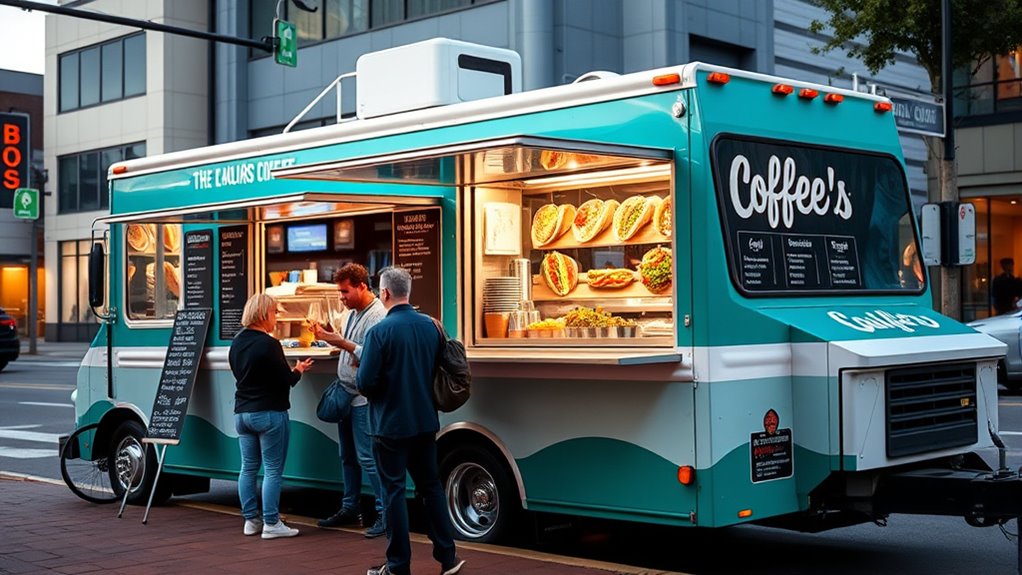
When designing your menu, consider incorporating seasonal ingredients and local flavors to attract customers and stand out. Keep a close eye on ingredient costs by using control techniques that maximize freshness without overspending. Additionally, applying mindful decluttering strategies to your inventory management can help prevent overstocking and reduce waste, further enhancing your cost control. By balancing these factors, you can create a compelling menu with pricing that appeals to your target audience.
Seasonal Ingredients and Local Flavors
Incorporating seasonal ingredients and local flavors into your menu not only appeals to customers seeking fresh, authentic dishes but also helps you stand out in Tacoma’s vibrant food truck scene. By focusing on seasonal ingredients, you can create dishes that highlight the freshest produce and meats available throughout the year. To do this effectively:
- Embrace local flavors by sourcing ingredients from nearby farms and markets.
- Rotate your menu items based on what’s in season, keeping offerings exciting.
- Highlight the story behind each ingredient to connect customers with Tacoma’s local food culture.
This approach not only boosts freshness and flavor but also aligns your brand with the community’s tastes, making your food truck a go-to destination for both locals and visitors.
Ingredient Cost Control Techniques
Designing your menu and pricing strategy with ingredient costs in mind is essential for maintaining profitability and offering value to your customers. Focus on ingredient sourcing to find quality products at lower prices, which can considerably reduce overall costs. Choose versatile ingredients that can be used across multiple menu items, simplifying procurement and minimizing waste. Regularly analyze your food costs to identify areas for cost reduction, such as negotiating better deals with suppliers or switching to more affordable alternatives without sacrificing quality. Streamlining your menu by removing expensive or underperforming items also helps control costs. By carefully balancing menu offerings and pricing, you ensure your food truck remains profitable while delivering tasty options that attract repeat customers.
Technology and Operations
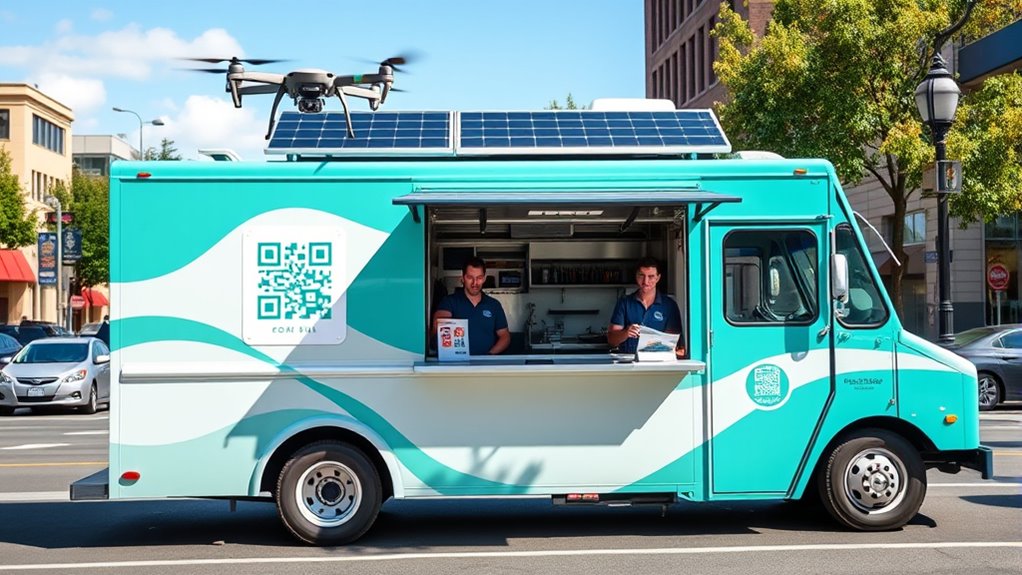
Using wireless payment terminals and apps makes transactions quick and easy for your customers. Real-time stock tracking software helps you stay on top of inventory and reduce waste. Incorporating these tools streamlines your operations and keeps your food truck running smoothly.
Wireless Payment Terminals and Apps
Have you ever wondered how food trucks like the one in Tacoma streamline their payment processes? Wireless payment terminals and apps make it easy. They enable cashless payments, speeding up transactions and reducing errors. To get started, you should:
- Choose a reliable payment terminal that supports mobile ordering and contactless payments.
- Integrate the terminal with your POS system for seamless sales tracking.
- Promote the use of apps to encourage mobile ordering, reducing wait times and increasing sales.
These tools improve efficiency, helping you serve customers quickly and keep lines moving. Plus, they offer convenience for customers who prefer paying via their smartphones. Implementing wireless payment solutions is essential for modern food trucks aiming to stay competitive in Tacoma.
Real-Time Stock Tracking Software
Implementing real-time stock tracking software allows your food truck to monitor inventory levels instantly, preventing shortages and overstocking. With effective inventory management, you can track ingredient usage and sales data in real time, ensuring you always have what you need. This technology streamlines ordering processes and reduces waste by providing accurate stock updates. Additionally, it enhances your delivery logistics by coordinating restocking schedules and minimizing delays. You’ll know exactly when to reorder supplies, avoiding costly shortages that can halt service. Real-time tracking also helps identify slow-moving items, enabling better menu planning. Overall, this software improves operational efficiency, keeps your inventory optimized, and ensures seamless service for your customers. It’s an essential tool for keeping your food truck running smoothly in the competitive Tacoma market.
Marketing and Growing Your Presence

To grow your food truck’s presence, start by planning a weekly event calendar that attracts different crowds and keeps your offerings fresh. Sharing eye-catching food photos on Instagram can boost engagement and draw new customers. Consistently combining these strategies helps you build a loyal following in Tacoma.
Weekly Event Calendar Planning
Wondering how to maximize your food truck’s visibility? Planning your weekly event calendar is key. Start with weekly event brainstorming to identify popular local gatherings, farmers markets, or festivals. Then, develop menu rotation strategies to keep your offerings fresh and exciting for repeat customers. To stay organized:
- Schedule your appearances at high-traffic events consistently.
- Coordinate with event organizers early to secure prime spots.
- Adjust your menu based on customer feedback and seasonal ingredients.
This approach ensures you stay top-of-mind and attract new customers. By aligning your weekly events with community happenings and offering rotating menu items, you create buzz and build loyalty. Consistency and adaptability are your best tools for growing your presence in Tacoma.
Engaging Instagram Food Photos
Capturing eye-catching Instagram food photos is essential for boosting your food truck’s visibility and attracting new customers. To stand out, focus on food styling that highlights your dishes’ best features. Use natural light and simple backgrounds to enhance your food photography. A well-composed shot can turn a casual viewer into a hungry follower. Here’s a quick guide:
| Tip | Technique | Result |
|---|---|---|
| Use natural light | Shoot during the day, avoid harsh shadows | Bright, vibrant photos |
| Keep it simple | Minimal props, clean plates | Focus on the food |
| Show movement | Drizzle sauces, steam from hot food | Adds energy and appeal |
| Angles | Overhead or close-up shots | Creates visual interest |
| Consistency | Stick to a style or filter | Builds recognizable brand |
Mastering food styling and food photography helps grow your Instagram presence and draws more customers to Tacoma’s food scene.
Master Tacoma’s Vibrant Food Scene

Tacoma’s food scene bursts with energy, offering a diverse range of flavors that reflect its vibrant community. To master this scene, focus on three key aspects:
- Food truck design – create an eye-catching setup that stands out and invites curiosity, making your truck a visual highlight on busy streets.
- Menu uniqueness – craft a menu that highlights local ingredients and bold flavors, capturing the essence of Tacoma’s culinary diversity.
- Customer engagement – connect with your audience through friendly interactions and social media, encouraging repeat visits.
Frequently Asked Questions
What Are the Peak Hours for Food Truck Traffic in Tacoma?
You’ll find peak times for food truck traffic in Tacoma during the lunch rush, typically between 11:30 a.m. and 1:30 p.m., when workers seek quick, tasty meals. Additionally, dinner hours from 5 p.m. to 7 p.m. see increased foot traffic, especially in busy neighborhoods and event venues. Planning your schedule around these peak times helps attract more customers and boosts your sales during the busiest hours.
How Do I Find the Best Locations for My Food Truck?
Think of your food truck as a magnet, drawn to urban hotspots bustling with potential customers. To find the best spots, do a competitor analysis—visit popular locations, note foot traffic, and see where others thrive. In Tacoma, areas near the waterfront or busy downtown streets often attract crowds. Your goal is to position yourself where energy flows strongest, maximizing your chances of turning passersby into loyal customers.
Are There Any Local Food Truck Associations or Networks in Tacoma?
Yes, there are local food truck groups and Tacoma food networks you can join. These groups connect you with other vendors, share tips, and help you find great spots. Check out the Tacoma Food Truck Association and social media pages for meetups and events. Joining these networks can boost your visibility, provide support, and open opportunities to collaborate. Engaging with local food truck groups helps you grow your business in Tacoma.
What Permits Are Needed for Special Events or Festivals?
Imagine your food truck rolling into a lively festival, ready to serve. To do this, you’ll need event permits and festival licensing from Tacoma authorities. These permits ensure your truck complies with health, safety, and zoning regulations. Apply early to avoid delays, and check specific requirements for each event. With proper licensing, you’ll be set to delight festival-goers while smoothly steering Tacoma’s permit process.
How Can I Build a Loyal Customer Base in Tacoma?
To build a loyal customer base in Tacoma, focus on strong branding strategies that make your food truck memorable. Use social media engagement to connect with locals, share your story, and promote special events. Offer excellent customer service and encourage feedback to create a sense of community. Consistently update your online presence and participate in local festivals to increase visibility. Over time, these efforts will turn new customers into loyal fans.
Conclusion
As you immerse yourself in Tacoma’s bustling food scene, you might find that the perfect location or unexpected partnership appears just when you need it most. Keep your passion alive and stay adaptable—sometimes, the most delicious opportunities come from the unlikeliest coincidences. With your dedication and a bit of luck, your food truck will become a beloved part of Tacoma’s vibrant community, turning every challenge into a tasty new adventure.

